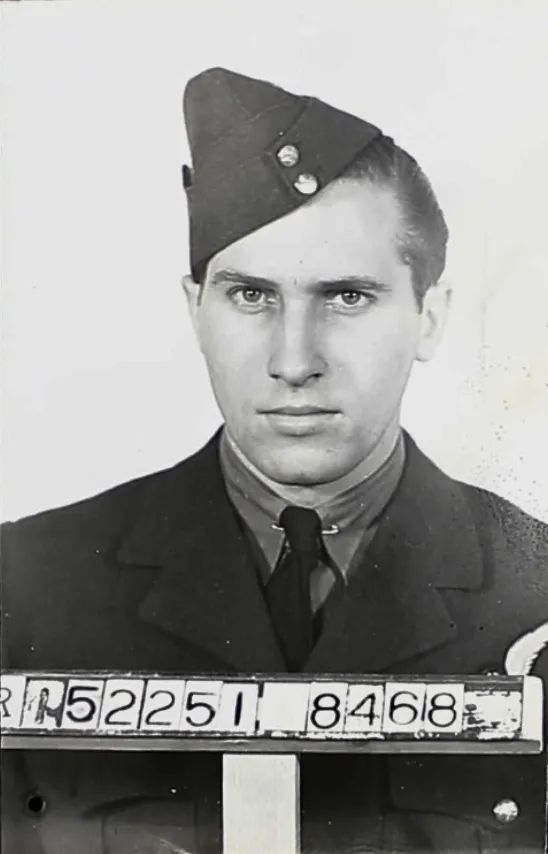Schlegel, Kenneth Eckert (Flight Sergeant)
Killed in Action 1943-August-03


Birth Date: 1920-November-14
Born:
Parents: Son of Herbert C Schelegel and Pearl (nee Boan) Schlegel, of Kitchener, Ontario, Canada.
Spouse:
Home: Bamberg, Ontario
Enlistment: Hamilton, Ontario
Enlistment Date: 1942-January-16
Service
RCAF
Unit
115 (B) Sqn- Squadron (RAF)
Despite The Elements
Base
RAF East Wretham
Rank
Flight Sergeant
Position
Air Gunner (Mid-Upper)
Service Numbers
R/152251
Home
Target
Temporary Burial
Remains were later exhumed from this location and reburied
Crew or Other Personnel
Lancaster DS673
Mission
Lancaster Mk.II DS673
Bombing Hamburg Germany 1943-August-02 to 1943-August-03
115 (B) Sqn (RAF) RAF East Wretham
115 Squadron (Despite The Elements) RAF East Wretham, Kent, England. Lancaster II aircraft DS 673 KO-V was lost on a night operation to bomb targets in Hamburg, Germany, shot down by night fighter pilot Oberfeldwebel Erich Heitmann of 2/NJG3. The Lancaster crashed in the Waddensea, 5 km South of Spiekeroog, Niedersachsen, Germany
Flight Sergeant Kenneth Eckert Schlegel (RCAF), Sergeant Dudley Herbert Read (RAFVR), Sergeant Herbert Alfred Sparrow (RAFVR), Flight Sergeant Dudley William Bellamy (RAFVR), Sergeant Robert William Bennett (RAFVR), Sergeant William Henry Hodges (RAFVR) and Sergeant Leslie Ernest Fuller (RAFVR) were all killed in action.
Nachtjagd Combat Archive 1943 Part 2, 23 June - 22 September by Theo Boiten, page 51
Lancaster serial: DS673

Canadian Warplane Heritage Museum
The Avro Lancaster is a British Second World War heavy bomber. It was designed and manufactured by Avro as a contemporary of the Handley Page Halifax, both bombers having been developed to the same specification, as well as the Short Stirling, all three aircraft being four-engined heavy bombers adopted by the Royal Air Force (RAF) during the same wartime era.
The Lancaster has its origins in the twin-engine Avro Manchester which had been developed during the late 1930s in response to the Air Ministry Specification P.13/36 for a capable medium bomber for "world-wide use". Originally developed as an evolution of the Manchester (which had proved troublesome in service and was retired in 1942), the Lancaster was designed by Roy Chadwick and powered by four Rolls-Royce Merlins and in one version, Bristol Hercules engines. It first saw service with RAF Bomber Command in 1942 and as the strategic bombing offensive over Europe gathered momentum, it was the main aircraft for the night-time bombing campaigns that followed. As increasing numbers of the type were produced, it became the principal heavy bomber used by the RAF, the Royal Canadian Air Force (RCAF) and squadrons from other Commonwealth and European countries serving within the RAF, overshadowing the Halifax and Stirling. Wikipedia
Unit Desciption
115 (B) Sqn Despite The Elements ()
No. 115 Sqn was originally formed on Dec 1, 1917 as a heavy bomber squadron and joined the Independent Air Force of the RAF in August 1918. It was disbanded in 1919, then re-formed in June 1937. It formed part of RAF Bomber Command No. 3 Group in WWII. Starting with Handley Page Harrow aircraft, it transferred to Vickers Wellingtons in 1939, which it flew until March 1943, when it transferred to Avro Lancaster B. Mk. II and later B. Mks I and III. Between April 1940 and September 1942 the squadron was seconded to Coastal Command and based at Kinloss, Scotland. It rejoined Bomber Command and flew from Mildenhall, East Wretham and Little Snoring in 1942 and 1943 before settling at Witchford, Cambridgeshire from November 1943 until the end of hostilities.
In April 1940 the squadron made the RAF's first bombing attack on the mainland of Europe, at Stavanger in Norway. In August of 1941 it participated in the service trials of the new navigational aid, GEE, and as a result of its report the device was put into mass production. Overall, in WWII the squadron flew 5392 sorties and dropped about 23,000 tons of bombs. This was the second-highest tonnage of bombs in Bomber Command. The squadron was 3rd in the number of raids in the course of the war. Since it was active over the whole span of WWI, it lost the greatest number of aircraft of any squadron in Bomber Command: it was the only squadron to lose more than 200 aircraft.

